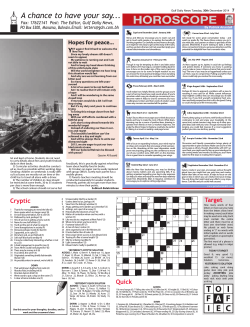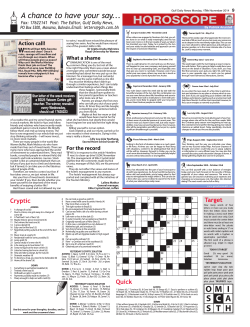
G 5 Model Paper Science A final
PUNJAB EXAMINATION COMMISSION
EXAMINATION 2015, GRADE 5
SCIENCE PART – A (Objective Type)
Model
Paper
Part-A = 50 Marks, Part-B = 50 Marks, Total Marks = 100
General Instructions:
1) Students are advised to choose a correct answer to every question.
2) Read each question carefully before answering.
!"#$%&
3) Do not take the question paper / answer sheet out of the examination centre.
'()%*+$,-./0123456
4) Mark the correct option of MCQ with a Black /Blue ink.
A;<,=$>?@:7289
5) More than one marked answers will not be considered.
AEFG'HIJHBCD(+/B3)$
6) Encircle the correct answer as shown in the example:
AK3LBMNO;</PBBQ
Example: Lizards belong to which group of vertebrates?
^_ `abc
d
Zv Y
o_ pqhrasqb tuwH
e_
Z
$STQUV[HT
W X Y \] RN
n
fghcaea^ib jklmY x_
y^gg^sb
z ~
{W |}Y
Part-A (Multiple Choice Questions)
Time Allowed: 50 Minutes
HT& A
B(8289M R(3
Instructions: -Twenty five (25) Multiple Choice Questions (MCQs) are given in this
part. Attempt all questions. All questions carry equal marks.
Q. No.1. Living things are divided into how many kingdoms?
(a) 2
(b) 3
(c) 4
KGM
TH
(d) 5
Q. No.2. The animals which live on land but reproduce in water are;
R
/T
M
H5 H/T
(a) amphibians
n
jklmY (b) fish
Grade-5, Science, Paper-A, Model Paper
(c) reptiles
Zv Y
tuwH
(d) birds
5
Page 1 of 5
Q. No.3. The given flower has five petals. This flower belongs to which group of plants?
¢H\$STQ£
TB¤ ¡ A
MB
(a) monocot
¥¦§
(b) dicot
¥¨©
(c) seedless plants
B¤ª«
(d) mosses
¤
Q. No.4. After seed germination, the cotyledons shrink because:
®
¯°±²³´µ¶5·¸ª
(a) root comes out from the cotyledons
A¹º$°±²
(b) stem comes out from the cotyledons A»¹¼$°±²
(c) leaves come out from the cotyledons A
¹½$
°±²
(d) food stored in cotyledons is used
AÀÁ¾H¿B§M °±²
Q. No.5. One cause of air pollution is:
AÅTÂBÃÄÀ
HÈÆÇ
(a) traffic noise
(c) excess use of fertilizers B3)BL
(b) contaminated water
/BÃÄ
(d) poisonous smoke
ÉBÊ)
Q. No.6. Identify the group of vertebrates which feed milk to their offspring:
Z
ËÌSTQVW[HT
X Y *T%ÍBTB
Î
(a) Dolphin, Toad
©ÏÐT©
(b) Whale, Dolphin
ÐT©ÑT
(c) Cow, Salamander
HÒÓFE
(d) Toad, Human being
,Ô©Ï
Q. No.7. An astronaut has 90kg mass on earth. What will be his or her mass in space?
ÂÀÚQÛ×MÕÚQÛØÙ5Ö)×)+Õ
(a) 130 kg
(b) 120 kg
(c) 90 kg
(d) 80 kg
Q. No.8. Which one is a non-biodegradable thing?
ÜÝÞß
(a) A plastic tyre áâàÍ
(c) A pea seed
(b) A piece of bread ã²THÝ©
ªä
(d) A banana skin
åæ
Q. No.9. Which organ of human body is directly affected by air pollution?
»ÀçèJH/éê,,Ô$ÂBÃĨÀ
(a) Lung ë
(b) Heart B
Grade-5, Science, Paper-A, Model Paper
(c) Stomach /ì
(d) Brain íîB
Page 2 of 5
Q. No.10. Ice-cream melts outside of a fridge because its particles:
R(Hõ¸¡ÅT%ï¸$ðHñòÄ+$óô
(a) move for shorter distances
A
ûüøùúö÷
(b) move for longer distances
A
ûüøHTBHTB
(c) move freely in all directions
A
ûüþB)Äý+
A
HÞ5
(d) stay at fixed positions
Q. No.11. Identify the solid object keeping in view the arrangement of its particles.
AËÌ
$*
(Hõ
(a)
(b)
(c)
(d)
Q. No.12. What would happen to your mass and weight if you reached the moon?
ÂÀG
¦,)THT×SÄ
;5SÄQ
(a) mass will increase, weight will decrease
AEÀ
,)TÂ×
(b) weight will increase, mass will decrease
AÂÀ×E,)T
(c) mass will remain same, weight will decrease
AEÀ
,)TÂH>×
(d) no effect on both
.E'
ô¨5
¦TB
Q. No.13. Which process causes the formation of clouds from vapours in the air?
£
z ÃB+$(HB§MÀ
z Y (a) evaporation
H
(b)
condensation
z !
z
Y v
(c) suspension
z (d) transpiration
Pu"Ç
v
Q. No.14. The device shown in the diagram is;
:/TK3LB#
ÄM
$
%
B
(a) Electromagnetic Device
#Ä('&
(b) Magnetic compass
(c) Stop watch
+TS,
(d) Ammeter
)* ('
Z -nY
W./Y m Q. No.15. The objects which do not allow light to pass through them are called opaque objects
and an example of an opaque object is:
N 123
234HT»01
23
2345
B%H6
TH$H81
/T
23
23
H6'7
(a) mirror
(c) tissue paper
9Ä
Z
;=
<
(b) clear water
2
:
(d) brown glass
>,C
Q. No.16. Fruits and vegetables are spoiled when not preserved in a fridge. This is due to:
(a) bacteria 3F
(b) virus PT
Grade-5, Science, Paper-A, Model Paper
R
@A
ÀB
CDMóô
3E
B$%þCD
CD
3EHT?
Z
(c) yeast GY Y (d) algae H
Page 3 of 5
Q. No.17. The correct arrangement of first four planets in our solar system is;
M~Y N
R
L TH?H#MI
ÚJHK
HK
(a) Earth, Venus, Mars, Mercury
BHOPQ/)Ö)
(b) Mercury, Venus, Earth, Mars
PQÖ)/)BHO
(c) Venus, Mars, Earth, Mercury
BHOÖ)PQ/)
(d) Mars, Venus, Earth, Mercury
BHOÖ)/)PQ
Q. No.18. An electromagnet can be made stronger by:
RM¸QR
3SHTU'
U'&
U'
(a) decreasing the number of turns in the coil
. F%B
HV
TWX
(b) increasing the number of turns in the coil
AF%BYBZ
TWX
(c) decreasing the flow of current
AF3BC[\
(d) stopping the flow of current
. F3B]C[\
Q. No.19. Which part of a mixture of sand, salt, plastic balls and iron nails may be
separated by using an electromagnet?
E^/_`£$MaÄbÃc+àÍdeHU'
U'&
U'
(a) Sand eH
(b) Iron nails bÃ
(c) Saltd
(d) Plastic ballfàÍ
Q. No.20. Due to which force does a book remain stationary on a table?
R/TkH%j
ê5a
i$ÅTA
(gh
(a) Inertia
Bl
(b) Friction
mH
(c) Balanced force
(g,)n
(d) Unbalanced force
(g,)n4
Q. No.21. Which planet has greater distance from the Sun than Mercury but less than Earth?
/B3)oBHO
o
Ö)qú$r
HA
/H?ê,/T
HOp
(a) Venus /)
(b) Mars PQ
(c) Jupiter %s
(d) Uranus tH
Q. No.22. In villages, houses are plastered with mud. For this purpose which type of soil is used?
ÀÁuv
,w
x
y$w
TH
THB(ßz
ßzM
CE
(a) Sand eH
(b) Silt سلٹ
(c) Clay w{
(d) Loam ÚÃ
Q. No.23. The conditions necessary for germination of seed are;
R
(8}
8}%TH|
TH|·ª
(a) suitable temperature, water
~
(b) fast wind, high temperature
~/B3)À
(c) water, no wind
ßÀþÀ
(d) high temperature, water
~/B3)
Q. No.24. Which type of soil allows minimum water to pass through?
Z
(a) Silt
|
B%H6
u
v
,w
H6$
(b) Loam ÚÃ
Grade-5, Science, Paper-A, Model Paper
(c) Clayw{
(d) Sand eH
Page 4 of 5
Q. No.25. Why is the Sun a star? It;
R¡
®/H
HrH
(a) is big in size
»ÀMê
(b) has its own light
¢H7TH
(c) is made up of rocks
»ÀÀS$
¦
(d) is made up of oxygen gas »ÀÀS Ä
Key of MCQs
Q.No.
1.
2.
3.
4.
5.
Key
d
a
b
d
d
Q.No.
6.
7.
8.
9.
10.
Key
b
c
a
a
c
Grade-5, Science, Paper-A, Model Paper
Q.No.
11.
12.
13.
14.
15.
Key
a
c
b
b
a
Q.No.
16.
17.
18.
19.
20.
Key
a
b
b
b
c
Q.No.
21.
22.
23.
24.
25.
Key
a
c
a
c
b
Page 5 of 5
© Copyright 2025













